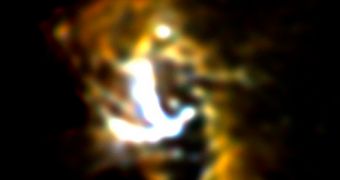A group of astronomers at Cornell University were recently able to discover a massive cloud of gas and dust around Sagittarius A*, the supermassive black hole at the center of the Milky Way. In addition, their observations have also revealed more details about a superluminous cluster located close by.
Observations were conducted using the NASA/DLR Stratospheric Observatory for Infrared Astronomy (SOFIA) airborne telescope, which is installed in the fuselage of a heavily-modified Boeing 747SP aircraft. The tool observes the Universe in infrared wavelengths and is well-suited for conducting observations of heated gas and dust clouds.
This type of sensitivity is also what enabled SOFIA to observe a cluster of extremely luminous, young stars right next to Sagittarius A*. This loosely-held-together structure features numerous blue stars, which are still embedded in the gas and dust cocoons from which they form. The amount of radiation they emit is so high that it heats these cocoons from within, making them glow in infrared.
According to a presentation Cornell expert Ryan Lay held last week at the American Astronomical Society (AAS) meeting in Long Beach, California, the massive gas and dust cloud surrounding Sagittarius A* is around 7 light-years in diameter and is called a circumnuclear ring (CNR).
Astronomer Matt Hankins, who is based at the University of Central Arkansas in Conway, is the lead author of a second paper detailing the findings, which deals with the neighboring quintuplet cluster (QC). Both images were obtained using the Faint Object Infrared Camera for the SOFIA Telescope (FORCAST) instrument aboard the aircraft, at 20, 32, and 37 microns.
“The focus of our study has been to determine the structure of the circumnuclear ring with the unprecedented precision possible with SOFIA. Using these data we can learn about the processes that accelerate and heat the ring,” Lau explains. He says that SOFIA can fly as high as 13.7 kilometers (45,000 feet), which puts it well above most water vapor in Earth's atmosphere.
“Something big happened in the Milky Way's center within the past 4 million to 6 million years which resulted in several bursts of star formation, creating the Quintuplet Cluster, the Central Cluster, and one other massive star cluster,” explains Hankins.
“Many other galaxies also have so-called ‘starbursts’ in their central regions, some associated with central black holes, some not. The Milky Way's center is much nearer than other galaxies, making it easier for us to explore possible connections between the starbursts and the black hole,” he adds.
SOFIA is a collaborative effort involving NASA and the Deutsches Zentrum für Luft- und Raumfahrt (DLR), or the German Aerospace Center. The airborne observatory takes off on most of its flights from the NASA Dryden Aircraft Operations Facility at LA/Palmdale Regional Airport, in California.

 14 DAY TRIAL //
14 DAY TRIAL //